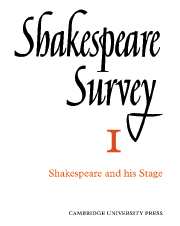Book contents
- Frontmatter
- Studies in the Elizabethan Stage since 1900
- Titus Andronicus on the Stage in 1595
- A Note on the Swan Theatre Drawing
- The Bankside Theatres: Early Engravings
- Shakespeare and the Blackfriars Theatre
- Shakespeare’s Bad Poetry
- The Folger Shakespeare Library
- The Heritage of Shakespeare’s Birthplace
- Three Shakespearian Productions: A Conversation
- Four Lears
- London Productions
- Stratford Productions
- International News
- The Year's Contributions to Shakespearian Study 1 Critical Studies
- 2 Shakespeare’s Life and Times
- 3 Textual Studies
- Books Received
- Index
- Plate section
Stratford Productions
Published online by Cambridge University Press: 28 March 2007
- Frontmatter
- Studies in the Elizabethan Stage since 1900
- Titus Andronicus on the Stage in 1595
- A Note on the Swan Theatre Drawing
- The Bankside Theatres: Early Engravings
- Shakespeare and the Blackfriars Theatre
- Shakespeare’s Bad Poetry
- The Folger Shakespeare Library
- The Heritage of Shakespeare’s Birthplace
- Three Shakespearian Productions: A Conversation
- Four Lears
- London Productions
- Stratford Productions
- International News
- The Year's Contributions to Shakespearian Study 1 Critical Studies
- 2 Shakespeare’s Life and Times
- 3 Textual Studies
- Books Received
- Index
- Plate section
Summary
The new regime at the Shakespeare Memorial Theatre, inaugurated by the Executive Council of the Governors of the Shakespeare Memorial Theatre under the chairmanship of Lieut.-Col. Fordham Flower, and directed by Sir Barry Jackson, has two seasons to its credit, so that one can distinguish the main changes in policy and attempt an estimate of what has been achieved. The most significant innovation has been the employment of a diversity of producers. Sir Barry has thrown his net wide—from Norwich to Yale, the old hand and the new, actor and academic, age and youth, ingenious experiment and sturdy tradition. This has been a great stimulus to all members of the company, and a valuable education hardly to be gained elsewhere. At the same time the method has its drawbacks. The players are constantly being called on to respond to a new producer and to accommodate themselves to very different views. This prevents stagnation, but is a severe tax on players who are asked to present a full series of plays each week as well as to rehearse the forthcoming productions.
The next notable change in policy is revealed in the lavish and sometimes extravagant expenditure on scenery and costume. While there have been some comparatively simple settings, such as that of Otis Riggs for Measure for Measure, or that of Sir Barry Jackson for Pericles, others have been more ambitious and less successful. Take, for example, the elaborate sets designed by Hal Burton for Richard II. These undoubtedly pleased the eye, but at times necessitated groupings and movements which lacked significance, or even militated against the realization of Shakespeare's ideas. The Deposition scene, which is the heart of the play, had none of the formal beauty of grouping and utterance which were clearly intended. Richard was too restless, and certainly the throne of contention should be set in the middle of the stage, as indeed must Richard be in the prison scene for the complicated soliloquy which expresses the Hamlet element in him—an element that Robert Harris or Walter Hudd failed, or perhaps did not desire, to convey.
- Type
- Chapter
- Information
- Shakespeare Survey , pp. 107 - 111Publisher: Cambridge University PressPrint publication year: 1948

